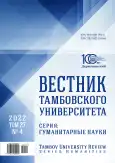Methodical aspects of the development of the ability to speak of students of the Faculty of Foreign Languages in a blended learning format
- Authors: Konovalova O.V.1
-
Affiliations:
- Kursk State University
- Issue: Vol 27, No 4 (2022)
- Pages: 988-998
- Section: THEORY AND METHODS OF FOREIGN LANGUAGE TEACHING
- URL: https://journal-vniispk.ru/1810-0201/article/view/298273
- DOI: https://doi.org/10.20310/1810-0201-2022-27-4-988-998
- ID: 298273
Cite item
Full Text
Abstract
The relevance of the research is due to the necessity to form and develop the speaking skills of Faculty of Foreign Languages students with a blended form of education and insufficient development of theoretical and technological tools for the effective implementation of this process. Blended learning is considered as a special type of educational activity, in which there is an alternation of traditional and distance learning technologies. We believe that blended learning has a significant potential for organizing the process of foreign language education in general and teaching speaking to students of the Faculty of Foreign Languages in particular. The specifics and advantages of the blended form of education for foreign language education are highlighted, as well as specific methods, techniques and tasks that can be successfully implemented in the process of teaching speaking in a blended format of education are given. The purpose of the study is to present the technological aspects of teaching speaking to students of the Faculty of Foreign Languages in a blended format of training and the development of educational and methodical support aimed at the implementation of this process. The novelty of the study lies in the fact that it analyzes digital resources that can be effectively used in the process of teaching speaking in a blended educational format, and also provides examples of specially designed exercises for the development of speaking skills that can be used in the process of training future specialists in foreign language education with a combination of traditional and online forms of education.
About the authors
O. V. Konovalova
Kursk State University
Author for correspondence.
Email: cherrygarcia@yandex.ru
ORCID iD: 0000-0001-7015-0838
Candidate of Pedagogy, Associate Professor of Language Theory and Methods of Teaching Foreign Languages Department
33 Radishchev St., Kursk 305000, Russian FederationReferences
- Holmberg B. The Evolution, Principles and Practices of Distance Education. Oldenburg, 2005, 171 p.
- Bersin J. “How Did We Get Here? The History of Blended Learning”. The Blended Learning Book: Best Prac-tices, Proven Methodologies, and Lessons Learned. San Francisco, John Wiley and Sons Publ., 2004, 319 p.
- Friesen N. Defining Blended Learning: Report. 2012, 10 p. Available at: https://www.normfriesen.in-fo/papers/Defining_Blended_Learning_NF.pdf (accessed 18.02.2022).
- Garrison D.R., Kanuka H. Blended learning: Uncovering its transformative potential in higher education. The Internet and Higher Education, 2004, vol. 7, issue 2, pp. 95-105. https://doi.org/10.1016/j.iheduc.2004.02.001
- Bonk C.J., Graham C.R. The Handbook of Blended Learning: Global Perspectives, Local Designs. San Francis-co, Jossey-Bass, Pfeiffer Publ., 2006, 624 p.
- Graham C.R. Blended Learning Systems: Definition, Current Trends, and Future Directions, San Francisco, 2006, 33 p.
- Watwood B., Nugent G., Deihl W. Building from Content to Community: Rethinking the Transition to Online Teaching and Learning. Richmond, Virginia Commonwealth University: Center for teaching excellence Publ., 2009. 22 p. https://doi.org/10.13140/RG.2.1.4357.1043
- Bernard R.M., Borokhovski E., Schmid R.F., Tamim R.M., Abrami P.C. The metaanalysis of blended learning and technology use in higher education: From the general to the applied, Journal of Computing in Higher Education, 2014, vol. 26, no. 1, pp. 87-122.
- Siemens G., Gasevic D., Dawson S. Preparing for the Digital University: a Review of the History and Current State of Distance, Blended, and Online Learning. Athabasca, Athabasca University Press, 2015, 235 p. https://doi.org/10.13140/RG.2.1.3515.8483
- Polat E.S. et al. Teoriya i praktika distantsionnogo obucheniya [Theory and Practice of Distance Learning]. Moscow, Publishing Center “Academy”, 2004, 416 p. (In Russian).
- Kapustin Y.I. Pedagogicheskiye i organizatsionnyye usloviya effektivnogo sochetaniya ochnogo obucheniya i primeneniya tekhnologiy distantsionnogo obrazovaniya: avtoref. dis. … d-ra ped. nauk [Pedagogical and Orga-nizational Conditions for an Effective Combination of Full-time Education and the Use of Distance Education Technologies. Dr. ped. sci. diss. abstr.]. Moscow, 2007, 40 p. (In Russian).
- Sysoyev P.V., Evstigneyev M.N. Metodika obucheniya inostrannomu yazyku s ispol’zovaniyem novykh infor-matsionno-kommunikatsionnykh internet-tekhnologiy [Methods of Teaching a Foreign Language Using New Information and Communication Internet Technologies]. Moscow, Glossa-Press Publ., Rostov-on-Don, Phoenix Publishing House, 2010, 177 p. (In Russian).
- Twigg C.A. Improving Learning and Reducing Costs: Lessons Learned from Round 1 of the PEW Grant Pro-gram in Course Redesign. Troy, Centre for Academic Transformation, Rensselaer Polytechnic Institute Publ., 2003, pp. 306-331.
- Cai H. E-learning and English Teaching. Procedia – Social and Behavioral Sciences, 2012, vol. 2, pp. 841-846. https://doi.org/10.1016/j.ieri.2012.06.180
- Kim S.H. Developing autonomous learning for oral proficiency using digital storytelling. Language, Learning and Technology, 2014, vol. 18, issue 2, pp. 20-35.
- Menggo S., Suastra I.M., Budiarsa M., Pandmadewi N.N. Needs Analysis of Academic-English speaking ma-terial in promoting 21st century skills. International Journal of Instruction, 2019, vol. 12, issue 2, pp. 739-754. https://doi.org/10.29333/iji.2019.12247a
- Sysoyev P.V., Evstigneyev M.N. Ispol’zovaniye novykh uchebnykh internet-tekhnologiy v obuchenii inostran-nomu yazyku (na materiale kul’turovedeniya SShA) [Use of new educational internet-technologies in foreign language teaching (On the material of cultural studies of the USA)]. Vestnik Tambovskogo universiteta. Seriya: Gumanitarnyye nauki – Tambov University Review. Series: Humanities, 2008, issue 2 (58), pp. 363-371. (In Russian).
Supplementary files









